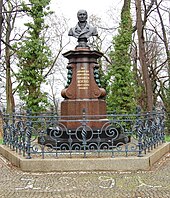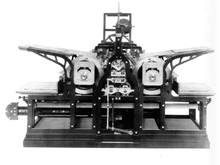Friedrich Koenig
Johann Friedrich Gottlob Koenig (born April 17, 1774 in Eisleben , † January 17, 1833 in Oberzell ) was a German printer and entrepreneur who is considered the inventor of the high-speed press . He was a co-founder of Koenig & Bauer , the oldest printing press manufacturer in the world.
biography
Although Koenig's parents were simple farmers, because of his above-average talent he was allowed to attend the private lessons of a pastor in Eisleben in addition to primary school. After the early death of his father, his family got even poorer; Nevertheless, he was able to attend high school . Upon his departure, the young king was certified as having particular knowledge of mechanics and mathematics .
In 1790 he began an apprenticeship as a book printer at the traditional book printing company Breitkopf & Härtel in Leipzig . He could not afford to study because of his financial circumstances. He was able to complete his apprenticeship after just four and a half years; at the time, this training normally lasted five years.
The interest in printing machines determined the further path of Koenig's life, even if he did not start working in his profession straight away, but instead attended university lectures in order to further his education. In 1802 he signed a contract with his childhood friend Friedrich Riedel in order to set up a bookstore with an attached print shop in his hometown. However, it was later agreed to invest the money (5000 thalers) in the development of an improved manual letterpress machine. In 1803 he began to construct a machine-operated printing press in Suhl , which could only be implemented as a functionally weak wooden structure ("Suhl press"). In pre-industrial Germany there was a lack of both sufficient knowledge of metalworking and the necessary capital to put Koenig's ideas into practice.
London years
In 1806 Koenig therefore moved to London and in 1807 signed a contract with the British printer owner Thomas Bensley to use his inventions. In London, Koenig met the precision mechanic and scientist Andreas Friedrich Bauer (1783-1860), who came from Stuttgart and had come to the British capital in 1805 for training purposes. In Britain, the industrial revolution had already begun in the second half of the 18th century - about 50 years before Germany and France - and British engineering was considered unrivaled by 1800. With Bensley's capital and Bauer's mechanical knowledge, it was possible to start building the unfinished Suhl machine (the “Suhl press”) entirely with specially manufactured metal parts.
A supplementary contract dated September 9, 1809 between Koenig and Bensley stipulated that the printers Richard Taylor (* 1781; † 1858) and Thomas Woodfall (1774-1848) would join the printing press company, and that Andreas Bauer would be Koenig's legal heir in the event of death. In 1810 Koenig and Bauer patented a platen printing machine, which they completed in 1811 in White Cross Street in London. The machine had an inking unit that distributed the printing ink with the help of rollers and applied it to the printing form. In the same year the first machine printing of a book succeeded.
In 1811 Koenig received the patent for the high-speed cylinder press, which revolutionized letterpress printing. On the night of November 28th to 29th, 1814, the London newspaper The Times was the first daily newspaper in the world to be produced with this cylinder printing machine and with steam power, because its publisher John Walter (the younger) had bought a machine from Friedrich Koenig. Walter himself wrote an editorial on November 29 in the world's first machine-printed newspaper. After Koenig had acquired various patents, he fell out with his financiers: They wanted to use the patented printing machines exclusively in their own printing works, while Koenig was interested in the industrial production of large numbers of his machines.
Koenig & Bauer
In 1817 he moved to Bavaria and founded the Koenig & Bauer machine factory with his business partner Andreas Bauer in the former Oberzell monastery near Würzburg . In 1828 Friedrich Koenig set up the first paper mill in the Kingdom of Bavaria in the Münsterschwarzach monastery mill . After his death in Oberzell in 1833 as a result of a long-standing heart condition, his widow Fanny Koenig (1808–1882) continued the business with Andreas Bauer.
Friedrich Koenig had a daughter Luise Koenig (1830–1928), who married the lawyer Moritz Bolza (1828–1891), whose second son Oskar Bolza (1857–1942) became a well-known mathematician.
Under Koenig's sons, Wilhelm Koenig (1826–1894) and Friedrich von Koenig (1829–1924), the company developed very successfully in the 19th century. They built high- speed letterpress presses and, since 1876, rotary machines . Wilhelm was the inventor of the two-color printing machine, which was built for the first time in 1864. Friedrich designed the first web press in 1875. In 1878 the first printing press with a four-roller double inking unit came onto the market.
Luise Koenig's first son, Albrecht Bolza (1862–1941) joined the company in 1886. Under his leadership, a new factory building was built at the current location on the right side of the Main (1901) and in 1905 the high-speed press factory Koenig & Bauer was converted into a GmbH . In 1919 Koenig & Bauer bought the high-speed press factory L. Kaisers Söhne in Mödling near Vienna . Since 1920 the company had the legal form of a stock corporation .
Albrecht's son Hans Bolza (1889–1986) started working for Koenig & Bauer in 1919 . At the end of 2007 Koenig & Bauer AG employed 8,250 people worldwide at nine locations and in 2006 achieved sales of 1.704 billion euros.
The Friedrich-Koenig-Gymnasium has been in Würzburg since 1974 after the inventor, entrepreneur and pioneer of the industrial development of Lower Franconia. He was honored with the Friedrich-Koenig monument in his hometown .
Print capacity
The table compares the production capacity of the printing machines invented by Koenig with that of their hand-operated predecessors:
| Hand operated presses | Steam powered machines | |||||
|---|---|---|---|---|---|---|
|
Gutenberg press around 1600 |
Stanhope press around 1800 |
Koenig machine 1812 |
Koenig machine 1813 |
Koenig machine 1814 |
Koenig machine 1818 |
|
| Prints per hour | 240 | 480 | 800 | 1,100 | 2,000 | 2,400 |
Further honors
In 1953 the Friedrich Koenig Medal was donated for special services in the field of printing machine construction. Friedrich-König-Straße has been a reminder of the work of the engineer and inventor in Suhl since 1993. After the two high schools in Suhl merged, the State High School in Suhl was named Friedrich-König-Gymnasium in 2015.
Quotes
- Friedrich Koenig: "We tend to forget that happiness is not the result of getting something that we do not own, but rather recognizing and appreciating what we have" (English "We tend to forget that happiness . " doesn't come as a result of getting something we don't have, but rather of recognizing and appreciating what we do have. " ) (quoted from: Amit Kothari: quotationsbook.com , London)
- "The physically rather skinny Koenig also devised the machine-driven printing press out of self-interest: During his apprenticeship he often suffered from the strenuous operation of the old hand presses." (Christian Vordemann: The machines that print money. In: Münchner Merkur from 10. June 2005)
literature
- Helfried Barnikel: Friedrich Koenig, an early industrial pioneer in Bavaria. The foundation of the world's first printing press factory (Oberzell near Würzburg 1817) and the first machine paper factory in Bavaria (Münsterschwarzach 1828). Dissertation , University of Munich, 1965.
- Albrecht Bolza: Friedrich Koenig. The inventor of the printing machine, a pioneer in the German machine industry. VDI-Verlag, Berlin 1933. (= treatises and reports / Deutsches Museum , Volume 5.1.)
- Hans Bolza: Friedrich Koenig and the invention of the printing machine. In: Technikgeschichte , 34th year 1967, No. 1, pp. 79–89.
- Theodor Goebel : Friedrich Koenig and the invention of the high-speed press. Schnellpressenfabrik Koenig & Bauer AG, Würzburg 1956.
- Siegfried Hänle: Koenig, Friedrich . In: Allgemeine Deutsche Biographie (ADB). Volume 16, Duncker & Humblot, Leipzig 1882, p. 506 f.
- Hans Jaeger: Koenig, Friedrich. In: New German Biography (NDB). Volume 12, Duncker & Humblot, Berlin 1980, ISBN 3-428-00193-1 , pp. 336-338 ( digitized version ).
- Friedrich Kasischke: Friedrich Koenig. Inventor of the printing machine and finisher of Gutenberg's art of printing. Koenig & Bauer, Würzburg 1999.
- George Naumann: AF Bauer. 1783-1860. Schnellpressenfabrik Koenig & Bauer AG, Würzburg 1960. (Contains as a reprint: Friedrich Koenig, Andreas Friedrich Bauer: Die Ersten Druckmaschinen. Brockhaus, Leipzig 1851.)
- Hans Popp: Friedrich Koenig and the invention of the high-speed press. Beltz, Langensalza 1934. (= sheet textbook and reading book for book printers. )
- Sigurd Rabe: The invention of the printing press by the German Friedrich Koenig. Lühe, Leipzig 1942. (= In Germany's Name , Volume 7.)
- Max Rößler: Friedrich Koenig. The inventor of the high-speed press. Echter, Würzburg 1982.
- Hans-Jürgen Wolf: History of the printing press. Interprint, Frankfurt am Main 1974.
Web links
- Literature by and about Friedrich Koenig in the catalog of the German National Library
- Internet presence of Koenig & Bauer AG as well as company history
- Friedrich Koenig (1774–1833): The inventor of the high-speed press. ( Memento from February 1, 2010 on WebCite ) Project of the advanced course history 1998/2000, Friedrich-Koenig-Gymnasium (Würzburg).
- Frederick Koenig: inventor of the steam-printing machine. ( Memento of October 20, 2011 in the Internet Archive ) Chapter VI from: Samuel Smiles : Men of Invention and Industry. John Murray, London 1884.
Individual evidence
- ↑ Hans-Bernhard Bolza-Schünemann : The Friedrich-Koenig-Gymnasium under the patronage of a brilliant inventor and technician. Excerpts from the speech [...] for the inauguration of the Friedrich-Koenig-Gymnasium. In: Kurt Fauster (Hrsg.): 5 years Friedrich-Koenig-Gymnasium. Würzburg 1978, pp. 4–7, here: p. 5.
- ↑ Hans-Bernhard Bolza-Schünemann: The Friedrich-Koenig-Gymnasium under the patronage of a brilliant inventor and technician. Excerpts from the speech [...] for the inauguration of the Friedrich-Koenig-Gymnasium. 1978, p. 5.
- ↑ Hans-Bernhard Bolza-Schünemann: The Friedrich-Koenig-Gymnasium under the patronage of a brilliant inventor and technician. Excerpts from the speech [...] for the inauguration of the Friedrich-Koenig-Gymnasium. 1978, p. 5 f.
- ↑ Hans-Bernhard Bolza-Schünemann: The Friedrich-Koenig-Gymnasium under the patronage of a brilliant inventor and technician. Excerpts from the speech [...] for the inauguration of the Friedrich-Koenig-Gymnasium. 1978, p. 6.
- ↑ Hans-Bernhard Bolza-Schünemann: The Friedrich-Koenig-Gymnasium under the patronage of a brilliant inventor and technician. Excerpts from the speech [...] for the inauguration of the Friedrich-Koenig-Gymnasium. 1978, p. 7.
- ^ Friedrich Kasischke: Fanny Koenig. Guardian of an inheritance. (Biography of a novel) Koenig & Bauer, Würzburg 2002.
- ^ Josef Hoeller-Peplinski: Schnellpressenfabrik Koenig & Bauer AG, Würzburg. An overview of the company's history. 6th section
- ↑ Hans-Bernhard Bolza-Schünemann: The Friedrich-Koenig-Gymnasium under the patronage of a brilliant inventor and technician. Excerpts from the speech [...] for the inauguration of the Friedrich-Koenig-Gymnasium. 1978, p. 7.
- ↑ Wolf (1974), p. 67f.
- ↑ Bolza (1967), p. 80
- ↑ Bolza (1967), p. 83
- ↑ Bolza (1967), p. 87
- ↑ a b Bolza (1967), p. 88
| personal data | |
|---|---|
| SURNAME | Koenig, Friedrich |
| ALTERNATIVE NAMES | Koenig, Johann Friedrich Gottlob (full name) |
| BRIEF DESCRIPTION | German printer, inventor and entrepreneur |
| DATE OF BIRTH | April 17, 1774 |
| PLACE OF BIRTH | Eisleben |
| DATE OF DEATH | January 17, 1833 |
| Place of death | Oberzell |





